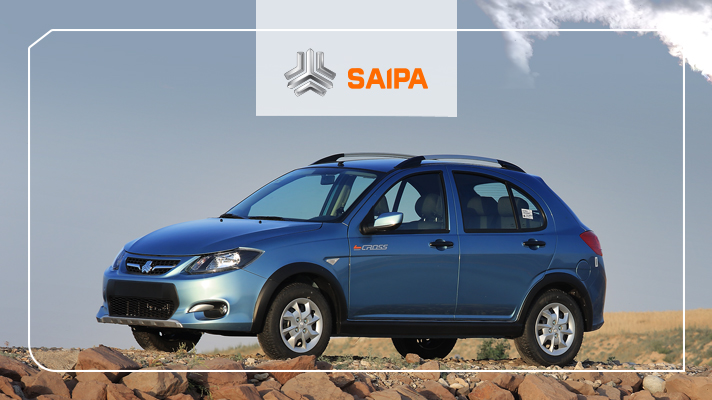
1001 Branding Spearheads SAIPA’s Mega Branding Project
Iranian automotive company SAIPA has embarked on a journey to overhaul its brand and reshape its image in the eyes of the public; and EBH is at the helm of this project.
Automotive company SAIPA is one of the largest industrial firms in Iran. A great portion of the Iranian workforce is directly employed by the firm and thousands of jobs are indirectly tied to the company.
SAIPA is a brand that many Iranians take pride in. Life experiences and memories of millions are linked to its products; memories like sitting behind the wheel of a vehicle for the first time and learning how to drive.
Cars made by SAIPA have been constant companions of millions of Iranians through their lives, from going on trips to making their living by working as cabbies.
Over the years, the firm’s budget cars have addressed the needs of the Iranian market. If there was no SAIPA, Iran would have been forced to import cars at higher prices, cars which many would not have been able to afford.
However, so far SAIPA’s brand image has been moored to one of its budget products, its small city car Pride. And despite all the perks and benefits of owning a Pride, a few “shortcomings” of the model have been mostly highlighted; shortcomings that no one would expect of any budget car anywhere around across the continents.
It merits mention that SAIPA’s inaction in dealing with negative news about the brand and some of its products has not helped to maintain and promote its brand.
Overhauling SAIPA’s brand identity is part of efforts for creating a more realistic image of the company.
In separate talks, Seyyed Ali Hasheminejad, head of SAIPA’s strategic studies department, Mazdak Zarinbakhsh, head of SAIPA’s studies, planning and polling center, Nasim Dana, art and creative director, and Mahsa Mirzaee, project manager at EBH have detailed the ongoing branding project.
***Boosting Cooperation, Coordination
Hasheminejad says, “The brand inconsistency at SAIPA has pushed us towards launching this new branding process. SAIPA has numerous subsidiaries and sub-brands. However, we lack a proper and effective brand architecture.”
According to the official, communication channels between different SAIPA subsidiaries are not working properly. This lack of functional communications has hampered effective branding.
“This lack of coordination has also hampered auto production and vehicle designing processes,” he notes.
Hasheminejad goes further and says that even different departments at SAIPA subsidiaries do not work as coordinately as they should. “The same applies to customer services departments and centers that are in charge of forging SAIPA’s general strategy.”
According to him, this lack of coordination becomes manifest again when SAIPA’s branding and general strategy are reviewed.
“Consider international automotive giants. Each offers cars under various brands which have different target markets. While these sub-brands seem independent and unrelated they are interlinked by the parent company’s strategy. This is while customers may stay unaware of this interconnections,” Hasheminejad notes.
Such integrated strategic approaches have been employed by international players like Volkswagen, and Toyota.
“This is while SAIPA’s sub-brands constantly highlight their relations with the parent company,” Hasheminejad says.
A common practice among automotive conglomerates in the world is sharing production facilities. However, the end-users are seldom made aware of this process.
Hasheminejad gives an example. Volkswagen Group has several subsidiaries including Czech automobile manufacturer Skoda and luxury brand Audi. He says that on some occasions VW might use Skoda production plants for making Audi cars.
The cars made at the Skoda plant meet Audi standards and the final products would meet customers’ expectations. This is while the two brands have different target markets and their products need to meet expectations which are poles apart.
Pointing to the differences between production management and branding at leading international automotive companies, Hasheminejad notes that the same approach to manufacturing and branding must be adopted by SAIPA.
According to him, SAIPA’s studies, planning, and polling center and the company’s strategic studies department have joined forces while enlisting EBH’s expertise to overhaul the automotive company’s brand.
A new brand architecture has been developed for SAIPA which will provide the automotive corporation with a way to grow and build its brand portfolio. The project is being constantly reviewed by top SAIPA managers and has their backing.
With EBH’s support, SAIPA’s brand book and new visual identity are being developed as well.
Furthermore, guidelines are being established that would lead SAIPA subsidiaries in their operations. The guidelines will also ensure that future changes in SAIPA’s management would not distort the brand’s identity. While future managers of SAIPA will be encouraged to implement innovative solutions the document will guide them in the process.
Hasheminejad says, “Implanting the branding project has not been an easy task.”
Those leading the endeavors have faced resistance from some SAIPA managers. “However, providing them with factual reports convinced them that the process is essential,” he says
Surveys indicated that all Iranians know SAIPA but the brand’s image has not been as strong as it could be.
The SAIPA official notes that after Iran’s historic nuclear deal was forged in 2016, the company had a golden chance to initiate a rebranding process along with introducing new vehicles into the market.
After the nuclear deal was implemented and sanctions were lifted, SAIPA and its international partners planned to introduce several new products into Iran’s auto market. During this process, SAIPA could have used the opportunity and reshaped its brand image.
“However, recent geopolitical developments have hampered SAIPA’s plans,” Hasheminejad says.
According to him, while SAIPA’s efforts for introducing new products into the market has been hindered, the firm is determined to go ahead with its rebranding plans.
The company has also devised a roadmap for having an active presence on social media platforms.
***Integrated Strategy
Zarinbakhsh also notes that SAIPA has numerous sub-brands and subsidiaries. “That is why an integrated branding strategy should be forged for the company.”
“To do so we had to establish whether we should introduce SAIPA as a family group along with its subsidiaries, or should we picture SAIPA as a parent firm with several sub-brands,” he adds.
According to him, each approach demands establishing a different brand architecture for the firm.
He continues by giving an example. “There was a time that SAIPA constantly highlighted the fact that Pars Khodro is a SAIPA subsidiary. This emphasis has done more damage to Pars Khodro than good.”
Furthermore, the lack of an integrated strategy has caused various issues over the years.
Zarinbakhsh says, “Some two years ago, high ranking SAIPA managers tried to initiate a promotional campaign for the company using SAIPA Yadak’s character.”
SAIPA Yadak is a subsidiary of the firm which is in charge of offering after-sales services to customers.
According to Zarinbakhsh, the campaign could not be developed for obvious reasons. A parent company cannot be represented by its subsidy’s character.
This issue pushed SAIPA managers to launch the project for reshaping the parent company’s character. “These efforts can culminate in the creation of a document that would lead us in brand management,” he notes.
***New Brand Image
SAIPA’s branding project was initiated some two years ago. In the early stages of the project, SAIPA managers and its customers were studied.
Mirzaee says, “Based on the findings, SAIPA’s new brand strategy was forged.” She notes that the company’s brand image has changed over time.
By producing a wide range of products, SAIPA has addressed the needs of many Iranians. Careers of thousands of people, including but not limited to taxi drivers, are tied to SAIPA cars; and many own vehicles made by the company.
“Almost all Iranians have treasured memories that are associated with SAIPA products. However, some over expectations of the brand’s products have sored these memories,” she added.
According to her, as part of the branding process customers’ positive memories are to be highlighted.
“SAIPA has been a constant companion of millions of Iranians. The company’s products have addressed the needs of millions of Iranians. Many of these people could not have afforded to buy cars made by other companies,” Mirzaee elaborates.
She further notes that when designing the brand’s character all these elements were considered.
Mirzaee attributes three key elements to the brand’s character: straightforward, friendly, and caring. “These attributes will soon become manifest at all customer touchpoints.”
“In our vision, everyone should be able to relate to SAIPA’s brand. Furthermore, everyone knows the name and products of the company. That’s why we included familiarity and friendliness among the core elements of the brand’s character,” she says.
According to her, SAIPA has been a constant companion of its customers. This companionship should and will become manifest in the brand’s slogan and tagline.
She further says that in line with the brand new strategy, SAIPA’s visual identity was designed. “Currently a team is working on SAIPA’s brand book.”
***Brand Book
Hasheminejad also spoke about SAIPA’s brand book and the role envisaged for it.
The brand book will include SAIPA’s short and long term strategy which will be ratified by top company managers. This strategy is hoped to reshape the company’s culture over time.
Over the past few years, numerous meetings were held with SAIPA managers informing them about the branding process. The continued discussions made the managers aware of the important role of branding. “These sessions have encouraged managers to always consider the brand’s identity and image when making decisions,” he said.
Furthermore, guidelines have been developed which SAIPA subsidiaries are required to follow. Hasheminejad said, “Roadmaps for all subsidiaries and departments are being forged as well.”
According to him, SAIPA subsidiaries have also been categorized into two groups. Companies falling in the first group need to follow SAIPA’s guidelines about visual identity while the other is classified as independent. However, the latter group is also encouraged to stay in line with some of the core elements of the parent company’s brand.
“As per the brand book we also need to upgrade our customer touchpoints,” Hasheminejad says adding, “However the process is both costly and time-consuming.”
He also notes, “Considering the economic headwinds Iran is facing, SAIPA managers have decided to curb spending. This has taken a toll on the project. However, by employing internal resources we have tried to move ahead and upgrade customer touchpoints whenever and wherever it has been possible.”
For instance, boosting SAIPA’s presence on social media platforms have been put high on the company’s agenda.
On a hopeful note, Hasheminejad said that as soon as the economic conditions improve “SAIPA would be able to implement the branding project completely.”
***Uphill Battle
Zarinbakhsh says, “Through the process, we faced various headwinds. Some SAIPA middle managers have resisted against change. Overcoming all these hurdles demanded unified efforts.”
He gave an example. “When we introduced SAIPA’s new logo we received some negative feedback from some company managers. Securing these managers support was no easy task.”
“One of the strategies implemented by our team was gradually introducing the changes. Over time, more people lent their support to the project. This has facilitated our work and boosted the results,” he says.
According to him, regular sessions are also held between professionals from EBH and SAIPA managers and decision-makers. During these sessions, company officials are familiarized with the branding process. Moreover, these meeting help EBH specialists establish a better understating of the firm and develop strategies that are in line with the company’s needs and budget.
Zarinbakhsh says, “One of our challenges has been helping some SAIPA sub-brands to develop independent identities from the parent company. Managers of these firms have been accustomed to being identified as SAIPA subsidiaries. We had to assure managers of these firms that SAIPA will continue to support them; that these changes will not translate into cutting them off from the parent company.”
To attain all these goals some structural reforms had to be implemented at SAIPA. “We have been successful in this process too,” he says.
***Data-Driven Strategy
Art and creative director Nasim Dana says that for developing an effective strategy “we carried out numerous rounds of surveys and researches. Based on the results and our general roadmap for the brand an innovative design strategy was developed for SAIPA.”
According to her three key elements that have been ingrained in SAIPA’s identity are being straightforward, friendly, and caring. Furthermore, “familiarity” has been determined as the core element of the brand.
“We kept these elements and our general strategy in mind throughout all designing processes. This has ensured the creation of an integrated brand identity for SAIPA,” she added.
SAIPA’s first logo was designed by Morteza Momayez, renowned pioneer of graphic design in Iran. The logo had been inspired by Gonbad-e Sorkh, a historic monument in Maraghe, Hormozgan Province, in south Iran.
“Generation after generation, Iranians have seen this logo on SAIPA products. That’s why we decided to minimize changes to the logo,” Dana explains.
She further said, “However, we had to upgrade the logo in line with the brand’s new strategy. We studied global examples and found out that leading automotive companies have softened the edges in their logs and added a metallic gleam to the design.”
This form and design, in addition to bringing to mind a connection to industries would draw more attention towards the logo.
While the logo has been subtly upgraded, its typography has undergone a noticeable facelift. “In the new version, we have tried to imply a sense of friendliness,” she notes.
The new typography in addition to conveying a sense of friendliness projects stability and reliability. “These are futures that can help boost an automaker’s brand image.”
One of the other aspects of SAIPA’s brand that needed to be overhauled was the company’s tagline. The Persian tagline can be loosely translated as “SAIPA, Trustworthy”.
The Persian word in the tagline in addition to trustworthiness implies concepts like endurance, and safety.
“Being associated with these concepts had overburdened the company with expectations that have taken a toll on the brand,” Dana says. And that is why the brand’s tagline should have been changed.
She adds, “When we were searching for a new tagline for the brand, we looked for something that would represent all the elements that we’d like to be associated with SAIPA; something that would remind people that SAIPA has been their companion for many years.”
According to her, SAIPA caters to the needs of many Iranians that might not be able to afford cars made by other automakers. Cars made by the company are used by a wide range of users and “you hardly can find someone in Iran that does not have a memory associated with SAIPA’s brand.”
She continues by adding that SAIPA has been a stalwart companion of Iranians for many decades and plans to stay by their side for many decades to come. “That’s why we came up with this tagline: SAIPA, Together Into the Future.”
SAIPA’s new visual elements, including the brand’s pattern and the brand’s identity have been designed in way to fit its upgraded logo and tagline.
***Economic Headwinds
During recent months, Iran has been facing economic headwinds that have taken a toll on local automotive companies. In the face of the hard times, some SAIPA managers wanted to pull the plug on the branding project.
However, Zarinbakhsh says, “I believe that during such hard times, successful companies of the future would invest in their infrastructure. Such investment includes spending resources on branding projects.”
On a hopeful note, Hasheminejad also noted that the hard times will soon pass. “Companies which have invested in branding will have a competitive edge over their rivals.”
The auto industry insider says that hopefully, the sector will find its way out of the current stagnation soon. “Until that day, we will move ahead and work on improving our brand.”
He believes that economic condition will change in the near future and SAIPA rivals will rush in to claim a bigger share of the market. “That’s when using a well-developed strategy SAIPA will outshine rivals.”
According to Hasheminejad, in addition to overhauling SAIPA’s brand, the introduction of new models are high on the company’s agenda. He says that the changes in SAIPA’s brand will be officially announced in tandem with the introduction of new vehicle models.
SAIPA’s Zarinbakhsh concluded his points by praising EBH’s team and its members for their professionalism, adaptability, agile approach to business, and creativity.
Hasheminejad says, “I take my hat off to EBH professionals. They are up-to-date and dedicated. They have been trusted confidants for us. Their spirit of companionship is priceless.”
For Instagram: A branding project for Iranian automotive company SAIPA has been designed and soon will be implemented. EBH has been in charge of SAIPA’s rebranding project. For carrying out this branding project EBH, SAIPA’s studies, planning, and polling center and the company’s strategic studies department have joined forces. Read more on dnaunion’s website.






